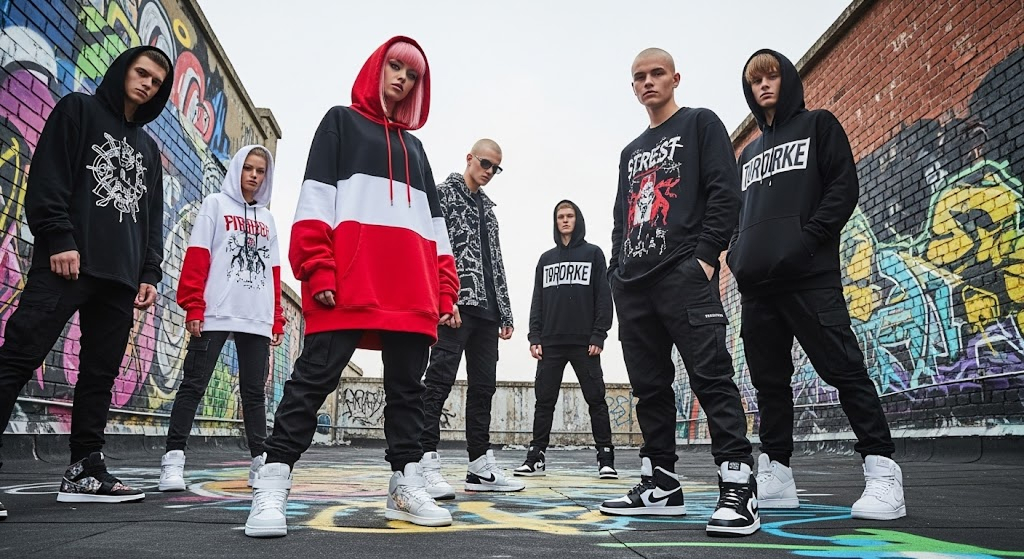Blog
Streetwear: From Subculture to Global Influence

Streetwear isn’t just a style—it’s a cultural revolution. Born from the streets, skateparks, and underground scenes, streetwear has grown into one of the most powerful movements in modern fashion. From its rebellious roots to its current status as a global luxury phenomenon, streetwear tells the story of identity, resistance, community, and reinvention.
What Is Streetwear?
At its core, streetwear is casual fashion inspired by the clothing and attitudes of subcultures—particularly skateboarding, hip-hop, punk, graffiti art, and basketball. It’s characterized by oversized fits, graphic prints, sneakers, hoodies, bold logos, and a DIY spirit.
But streetwear is more than a look—it’s a language. A way of expressing individuality, belonging, and sometimes defiance. It’s the fashion of the people, not dictated by haute couture but shaped by the streets, the fans, and the creators themselves.
The Origins of Streetwear
Streetwear began to take shape in the 1980s and early 1990s in cities like Los Angeles, New York, and Tokyo. In California, skate and surf brands like Stüssy began making limited-run graphic tees that quickly gained cult followings. In New York, hip-hop culture brought baggy jeans, gold chains, and sneakers into the mainstream, with brands like FUBU (“For Us, By Us”) reflecting pride and empowerment in Black communities.
In Japan, A Bathing Ape (BAPE) combined street sensibility with high-design precision, sparking a wave of limited-edition releases and exclusive drops that would later define the streetwear hype model.
What united these scenes was a sense of DIY authenticity. These were not luxury fashion houses telling people what to wear. They were communities, artists, and subcultures dressing for themselves—and in doing so, setting new standards of cool.
The Hype Economy: Limited Drops and Exclusivity
One of the most defining features of modern streetwear is its embrace of scarcity. Limited releases—or “drops”—create hype, demand, and community excitement. People line up for hours, sometimes even days, to score rare items from brands like Supreme, Palace, or Off-White.
The resale market turned these drops into a form of currency. A hoodie that retailed for $150 might sell for $600 the next day. Suddenly, fashion wasn’t just about wearing clothes—it was about owning cultural capital.
This drop-based economy has also shifted how fashion brands operate. Instead of seasonal collections, many now opt for smaller, faster, and more exclusive releases, driven by social media buzz and street credibility.
Streetwear Meets High Fashion
In the 2010s, the fashion world experienced a seismic shift: streetwear went high fashion.
Luxury brands that once dismissed sneakers and hoodies began embracing them. Collaborations between legacy houses and streetwear labels—such as Louis Vuitton x Supreme, Dior x Air Jordan, or Gucci x The North Face—blurred the lines between street culture and couture.
Designers like Virgil Abloh (Off-White, Louis Vuitton) and Demna Gvasalia (Balenciaga) helped redefine what luxury could look like. Hoodies, sneakers, and cargo pants made their way onto Paris runways, worn not with irony, but with reverence.
This fusion raised questions: is streetwear still streetwear when it costs thousands? Is it still rebellious if it’s sanctioned by the very fashion elite it once resisted?
Streetwear and Identity
One reason streetwear resonates so strongly is its connection to identity. Clothing becomes a statement—about where you’re from, what music you listen to, what you stand for. Whether it’s a vintage Wu-Tang tee, a Thrasher hoodie, or custom Air Force 1s, each piece tells a story.
Streetwear also intersects deeply with issues of race, class, and access. Many of its pioneers were Black, brown, working-class, and queer—groups historically excluded from high fashion. In many ways, streetwear gave them a voice, a platform, and a style they could own.
As streetwear entered luxury markets, some of that authenticity risked dilution. But it also brought long-overdue representation and opened the doors for new generations of creatives to redefine fashion on their own terms.
Streetwear in the Digital Age
Social media has turbocharged the streetwear movement. Platforms like Instagram, TikTok, and YouTube have made street style global. Fashion no longer trickles down from elite runways—it flows laterally, from influencers, local creators, and style communities around the world.
Apps like SNKRS and Grailed turned streetwear into an interactive game of access, resale, and exclusivity. Independent designers can now launch labels without traditional gatekeepers, reaching audiences directly through drops and storytelling.
And yet, the risk of over-commercialization looms. As more brands try to cash in on streetwear’s popularity, the space grows crowded, and the original spirit—DIY, culture-driven, defiant—can get lost in the noise.
The Future of Streetwear
Streetwear isn’t dying—it’s evolving. The movement is shifting from hype to heritage, from trend to storytelling. Today’s consumers are asking deeper questions: Who made this? What does it represent? Is it made to last?
Some of the most exciting streetwear brands now focus on:
- Sustainability (e.g., PANGAIA, Story mfg.)
- Artisan craft and slow production
- Local culture and community stories
- Collaborations with marginalized voices
Streetwear’s greatest power has always been its adaptability. It doesn’t need to live in any one place, price point, or aesthetic. As long as there are people looking to express who they are, streetwear will have a place in fashion’s future.
